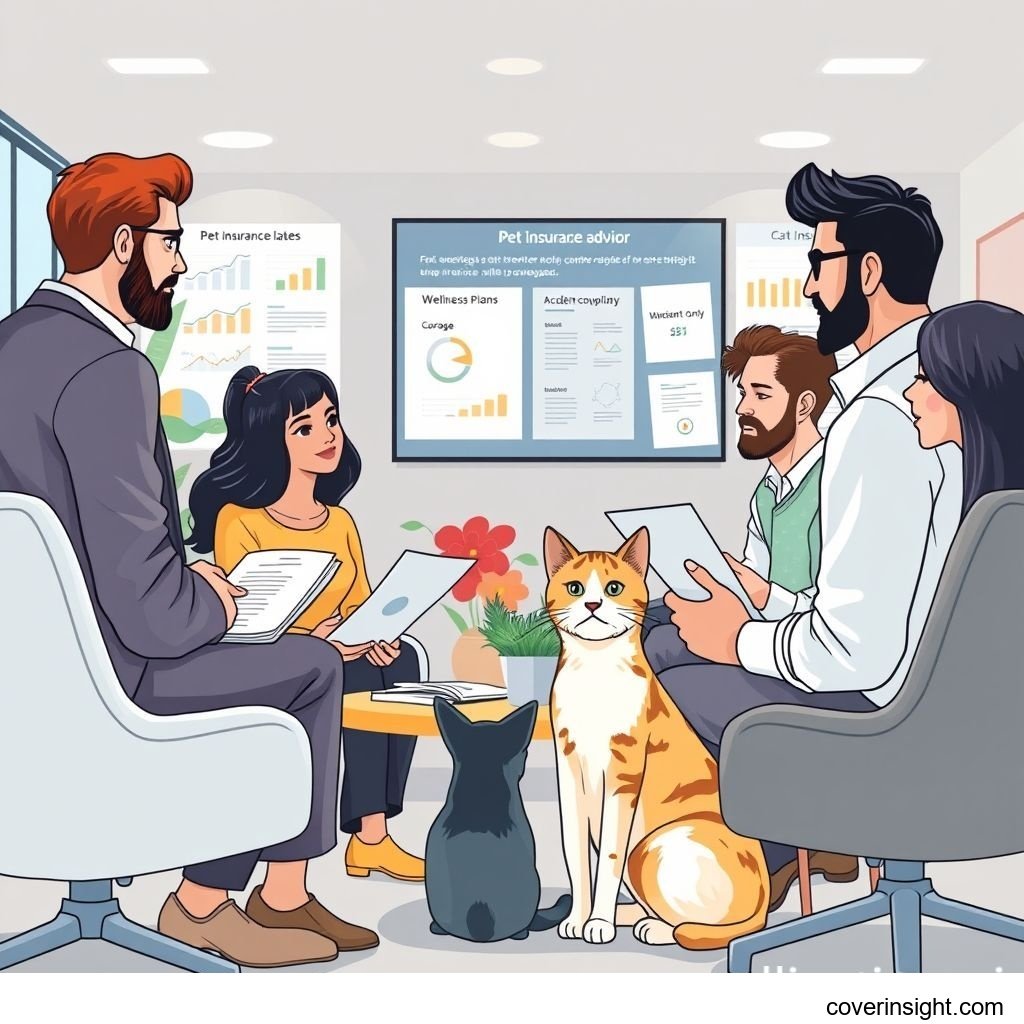Introduction
As we head into 2025, the landscape of pet care in the US continues to evolve, with more pet parents recognizing the invaluable safety net that cat insurance with wellness coverage provides. For many, a beloved feline companion isn't just a pet; they're a cherished family member. Just like with human healthcare, unexpected accidents or illnesses can lead to eye-watering veterinary bills. This guide aims to demystify the costs and benefits, helping you make an informed decision to protect your furry friend and your wallet. Investing in comprehensive coverage means peace of mind, ensuring your cat gets the best possible care without financial strain dictating crucial medical decisions.
Coverage Details
What’s Included
A robust cat insurance policy typically starts with core coverage for accidents and illnesses. This means if your cat suddenly ingests a foreign object, breaks a leg, or develops a chronic condition like diabetes or hyperthyroidism, the policy helps cover the costs of diagnostics, treatments, medication, and even specialist visits.
When you add wellness coverage, you're stepping up to a proactive approach to your cat's health. This optional add-on is designed to cover routine, preventive care expenses that aren't typically associated with emergencies or illnesses. Think of it as your cat's annual check-up fund. What’s often included under wellness are:
-
Annual veterinary exams and consultations
-
Routine vaccinations (e.g., rabies, FVRCP)
-
Flea, tick, and heartworm prevention
-
Annual deworming
-
Spaying or neutering procedures
-
Routine dental cleanings
-
Urinalysis and fecal tests
This preventive care is crucial for catching potential health issues early, which can save a lot of heartache and money down the road.
Common Exclusions
While comprehensive, cat insurance isn't a silver bullet for every veterinary expense. Understanding common exclusions is key to avoiding surprises. Generally, policies will not cover:
-
Pre-existing conditions: Any illness or injury your cat had before the policy started or during its waiting period. This is a big one, so it’s wise to insure your cat while they're young and healthy.
-
Experimental or investigational treatments: Procedures or medications not widely accepted by the veterinary community.
-
Cosmetic or elective procedures: Tail docking, ear cropping, declawing, or other procedures not medically necessary.
-
Grooming: While dental cleaning might be covered by wellness, general grooming expenses like nail trims or baths are typically not.
-
Breeding, pregnancy, or birthing: Complications related to breeding are usually excluded.
-
Behavioral issues: While some progressive policies might cover consultations with a veterinary behaviorist, many traditional plans do not.
It’s always a smart move to thoroughly read the policy documents or speak directly with providers, perhaps by reviewing resources available via "State Insurance Departments" to clarify what is and isn't covered.
Cost Analysis
Price Factors
The cost of cat insurance with wellness coverage isn't one-size-fits-all; it's a dynamic figure influenced by several key factors. Understanding these can help you estimate your potential premiums:
-
Your Cat's Age: Younger cats are generally cheaper to insure. As cats age, they become more susceptible to various health issues, leading to higher premiums. An 8-year-old cat will almost certainly cost more to insure than a kitten.
-
Breed: While less pronounced than with dogs, some cat breeds are predisposed to certain genetic conditions. For instance, Maine Coons might be prone to hip dysplasia, and Persians to polycystic kidney disease, potentially influencing premiums.
-
Location: Veterinary care costs vary significantly across the US. Insurers factor in the average cost of treatment in your ZIP code. Urban areas with higher costs of living, like New York City or Los Angeles, typically see higher premiums than rural areas. According to data often cited by the American Veterinary Medical Association (AVMA), emergency veterinary visits in the U.S. can range from a few hundred dollars to several thousand, heavily influenced by regional pricing.
-
Coverage Level: This is perhaps the biggest determinant.
-
Deductible: The amount you pay out-of-pocket before your insurance kicks in (e.g., $250, $500). A higher deductible means lower monthly premiums.
-
Reimbursement Percentage: The percentage of covered vet bills the insurer pays after the deductible (e.g., 70%, 80%, 90%). A higher reimbursement means higher premiums.
-
Annual Limit: The maximum amount the policy will pay out in a year. Policies with higher annual limits typically cost more.
-
Wellness Add-on: Adding wellness coverage will naturally increase your premium, but it can offset routine costs like vaccinations and check-ups.
-
Saving Tips
Nobody wants to pay more than they have to. Here are some savvy ways to potentially lower your cat insurance premiums or maximize your value:
-
Start Early: Insuring your cat when they are young and healthy helps lock in lower rates and avoids pre-existing condition exclusions later. It’s like getting in on the ground floor.
-
Multi-Pet Discounts: Many providers offer discounts if you insure more than one pet. If you have a cat and a dog, or multiple cats, this can be a significant saving.
-
Pay Annually: Opting to pay your premium once a year instead of monthly often results in a small discount.
-
Choose a Higher Deductible/Lower Reimbursement: If you have an emergency fund and are comfortable covering a larger initial portion of a vet bill, a higher deductible will reduce your monthly premium. Similarly, choosing an 80% reimbursement instead of 90% can save money on premiums, though you’d pay more out-of-pocket on claims.
-
Shop Around: Prices and policies vary widely between providers. Get quotes from multiple companies to compare coverage and costs. Websites like the "National Association of Insurance Commissioners" can offer guidance on what to look for in a reputable insurer. Don't be afraid to cast a wide net; you might be surprised by the differences.
-
Bundle Policies: Sometimes, if you have other insurance policies with a company (e.g., home or auto), they might offer a discount on pet insurance.
FAQs
How much does cat insurance with wellness coverage cost?
On average, you can expect to pay anywhere from $30 to $60 per month for a comprehensive cat insurance policy that includes wellness coverage in the US. However, this is a broad range. A young, healthy domestic shorthair in a lower-cost-of-living area might be at the lower end, while an older, purebred cat in a major metropolitan area with high reimbursement and a low deductible could push towards the upper end or even exceed it. For perspective, consider a real-world scenario: An unexpected emergency like a urinary blockage, a common feline issue, could easily rack up a bill of $1,500 to $3,000 for diagnostics and treatment. Without insurance, that’s all out-of-pocket, whereas with a good policy, you might only pay your deductible and a co-pay.
What affects premiums?
Premiums are primarily affected by your cat's age, breed (to a lesser extent than dogs), and your geographical location. Additionally, your chosen plan's specifics—such as the deductible amount, the reimbursement percentage, and the annual payout limit—play a huge role. Adding wellness coverage is also a direct factor in increasing the premium, though it covers routine care.
Is it mandatory?
No, cat insurance is not mandatory in the US. Unlike auto insurance in most states, there's no legal requirement to have pet insurance. However, the financial implications of not having it can be severe. Without coverage, every vet bill, from an annual check-up to a life-saving surgery, falls entirely on your shoulders. Many pet parents find great value in it, viewing it as a buffer against unforeseen and potentially devastating veterinary costs. For more general "Insurance Resources Global", many entities highlight the benefits of various forms of coverage.
How to choose?
Choosing the right policy involves a bit of homework. First, assess your cat's specific needs (age, health history) and your financial comfort level. Consider your budget for monthly premiums versus your willingness to pay out-of-pocket for a deductible or co-pay. Compare different providers' plans, looking closely at what’s included and excluded, waiting periods, and customer service reviews. Think about whether the wellness add-on makes financial sense for your cat’s routine care needs. Don't just pick the cheapest; pick the one that offers the best balance of coverage, cost, and reliability for your situation. You can also visit "US Insurance Home" for broader advice on navigating insurance markets.
Consequences of no coverage?
The primary consequence of having no pet insurance coverage is bearing 100% of all veterinary costs. This can lead to difficult decisions in an emergency. Imagine your cat needing an MRI, which could cost $2,000-$4,000, or emergency surgery for an injury, potentially running into $5,000-$10,000. Without insurance, some families are forced to choose between significant financial hardship and foregoing necessary, life-saving treatment for their beloved pet. It’s a tough spot to be in, and one that insurance aims to help you avoid.
Author Insight & Experience
Based on my experience as someone living in the US and navigating pet care for years, I've seen firsthand the emotional and financial toll that unexpected veterinary emergencies can take. There's nothing quite like the knot in your stomach when the vet presents a treatment plan costing thousands of dollars, knowing your furry companion's life depends on it. Pet insurance isn't just about covering costs; it's about buying peace of mind. It allows you to make medical decisions based on what’s best for your cat, not just what your immediate bank balance dictates. While the monthly premium might feel like another bill, it's an investment in your pet's long-term health and your own financial stability, ultimately preventing that 'gut punch' moment when a huge vet bill lands on your lap.








Comments